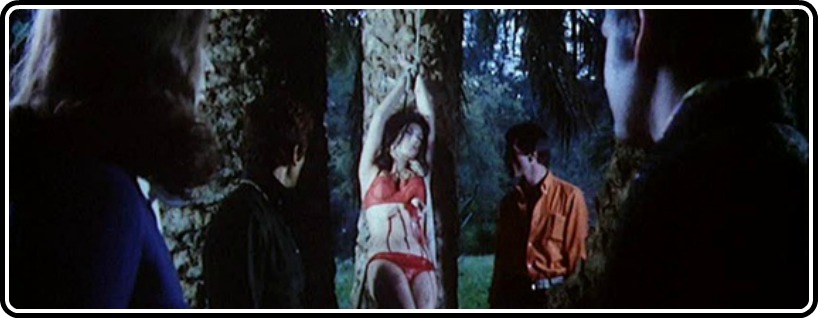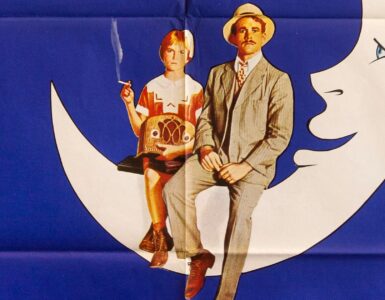When one thinks of a name like Mario Bava, the last thing a person thinks of are murder mysteries, let alone those inspired by legendary writer Agatha Cristie, but that’s the exact source from which legendary genre auteur Bava took inspiration for one of his most interesting and singular pieces of work.
Entitled Five Dolls For An August Moon, the film is loosely based on Cristie’s novel And Then There Were None, and tells the story of ten guests all of whom are invited to a posh extremely-mod island mansion, with the hopes of getting hold of a new scientific discovery made by leader of all this, Professor Farrell. When guests slowly start getting offed one after the other in mysterious, awe-inspiringly brutal ways, the film’s narrative turns from what seems to be an erotic thriller (the film opens rather wonderfully, particularly as we become introduced to the characters during a party scene) into a taut if not all that groundbreaking murder mystery.
To say this film isn’t groundbreaking isn’t entirely doing this film a disservice. At its very core, Bava’s film is relatively light on plot, light on themes and ultimately light on stakes. Performances have never been the strongest suit of Bava’s canon, and while that does not include the relatively kinetic and utterly enthralling turn from the ever beautiful Edwige Fenech who is introduced in a purely Bava-esque manner, both seductive and fiery, this film isn’t a bastion of great performances. Across the board one note, turns from the likes of William Berger, Ira von Furstenberg and Maurice Poli all fall as flat as a dead corpse falling from a noose. The chemistry shared between each member of the group here is almost non-existent, and while the drama come the film’s final act does become a tad heightened, it’s entirely due to Bava’s hand aesthetically and the brazenly off kilter score given to the film from Piero Umilani.
Speaking of that Umiliani-penned collection of tunes, it’s as breathtaking a score as one could ever imagine hearing from this type of genre picture. A time capsule from this type of early-70s bit of pop composition, the film finds much of its tension built on the ground work laid not only by Bava’s filmmaking but this percussive bit of pop film composing. Not quite as brooding a score as Bava would get for many of his pure thrillers and horror pictures, Umiliani’s score feels ripped right out of a mod era that fostered this type of score primarily in spy pictures or sexually-tense comedies. It’s a really superb score that, particularly during the sequences where people are offed, really becomes sonically thrilling and utterly bombastic.
However, the real star here has to be Bava, a filmmaker seemingly out of his comfort zone but one who fits better than previously imagined within this type of genre. Ostensibly a standard, cliché-filled whodunit, a run-of-the-mill giallo picture, the film is intensely intriguing if only due to Bava’s control of his frame. With beautiful photography from Antonio Rinaldi that is perfectly set against this posh and lavishly set-decorated backdrop and cinematography that particularly comes alive during the sequences that involve the reveal of yet another dead body. These set pieces are actually quite superb, with each guest finding their own special way of having their lives ended, and Bava’s direction (such as the occasionally startling use of a zoom effect that may be jarring for most but will excite others) really makes this film shockingly entertaining and entertainingly shocking.
And it is a film that has been given new life thanks to Kino and their brand new Blu-ray of the film. The transfer here looks good, the transfer really adding vibrancy to the neon hues, and the audio transfer makes this score sound absolutely breathtaking. Tim Lucas is all over this release in the form of a new audio transfer that proves him as a true genius with regards to how to properly approach these releases. As with his recent Jess Franco commentaries on Kino’s Blu-ray releases, this is both an engaging and deeply insightful commentary and one that adds a ton of depth to an otherwise small release. There are trailers for other Bava pictures, but this is the only real supplement to speak of.
Now, while that may seem like a light release that is itself a release of a minor picture in Bava’s canon, this is as intriguing a release as you’ll find this week. Yes, the film itself is a weak digression from a filmmaker more akin to pure slasher/horror work (see the superb A Bay of Blood, also released this week on Blu-ray by Kino, more on that film later this week), but it’s also a truly entrancing giallo film that makes up for the weak performances by finding a director fully in tune with his craft and a composer hell bent on making a score unlike anything you’ll hear from this type of thriller. Truly a film entirely all its own, it’s a film that genre hounds will jive perfectly with, and Bava fans will find more than enough to dig deep into. A minor work from an auteur as singular as Bava is still something of importance, and this is definitely a film one needs to check out.






![Bergman Island (The Criterion Collection) [Blu-ray]](https://criterioncast.com/wp-content/uploads/2022/11/bergman-island-the-criterion-collection-blu-ray-400x496.jpg)
![This Is Not a Burial, It’s a Resurrection (The Criterion Collection) [Blu-ray]](https://criterioncast.com/wp-content/uploads/2022/11/this-is-not-a-burial-its-a-resurrection-the-criterion-collection-blu-ray-400x496.jpg)
![Lars von Trier's Europe Trilogy (The Criterion Collection) [The Element of Crime/Epidemic/Europa] [Blu-ray]](https://criterioncast.com/wp-content/uploads/2022/11/lars-von-triers-europe-trilogy-the-criterion-collection-the-element-of-400x496.jpg)
![Imitation of Life (The Criterion Collection) [Blu-ray]](https://criterioncast.com/wp-content/uploads/2022/11/imitation-of-life-the-criterion-collection-blu-ray-400x496.jpg)
![The Adventures of Baron Munchausen (The Criterion Collection) [4K UHD]](https://criterioncast.com/wp-content/uploads/2022/11/the-adventures-of-baron-munchausen-the-criterion-collection-4k-uhd-400x496.jpg)
![Cooley High [Criterion Collection] [Blu-ray] [1975]](https://criterioncast.com/wp-content/uploads/2022/11/cooley-high-criterion-collection-blu-ray-1975-400x496.jpg)